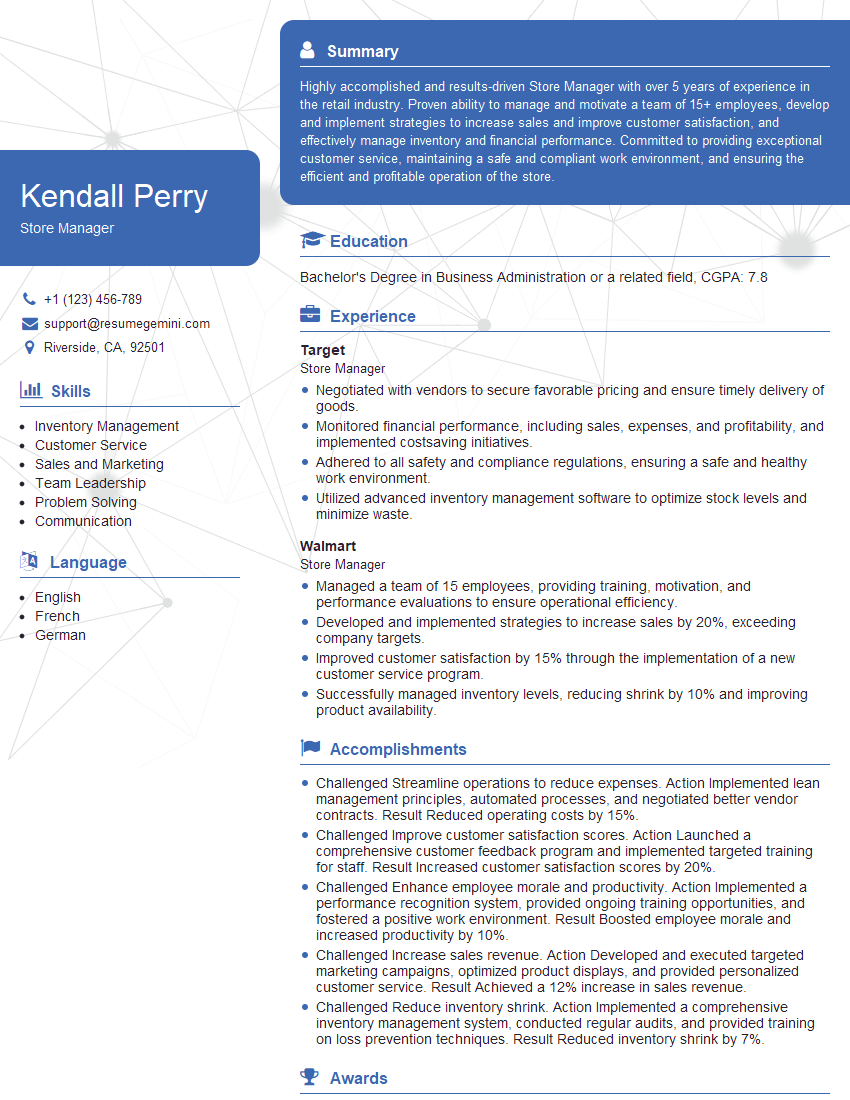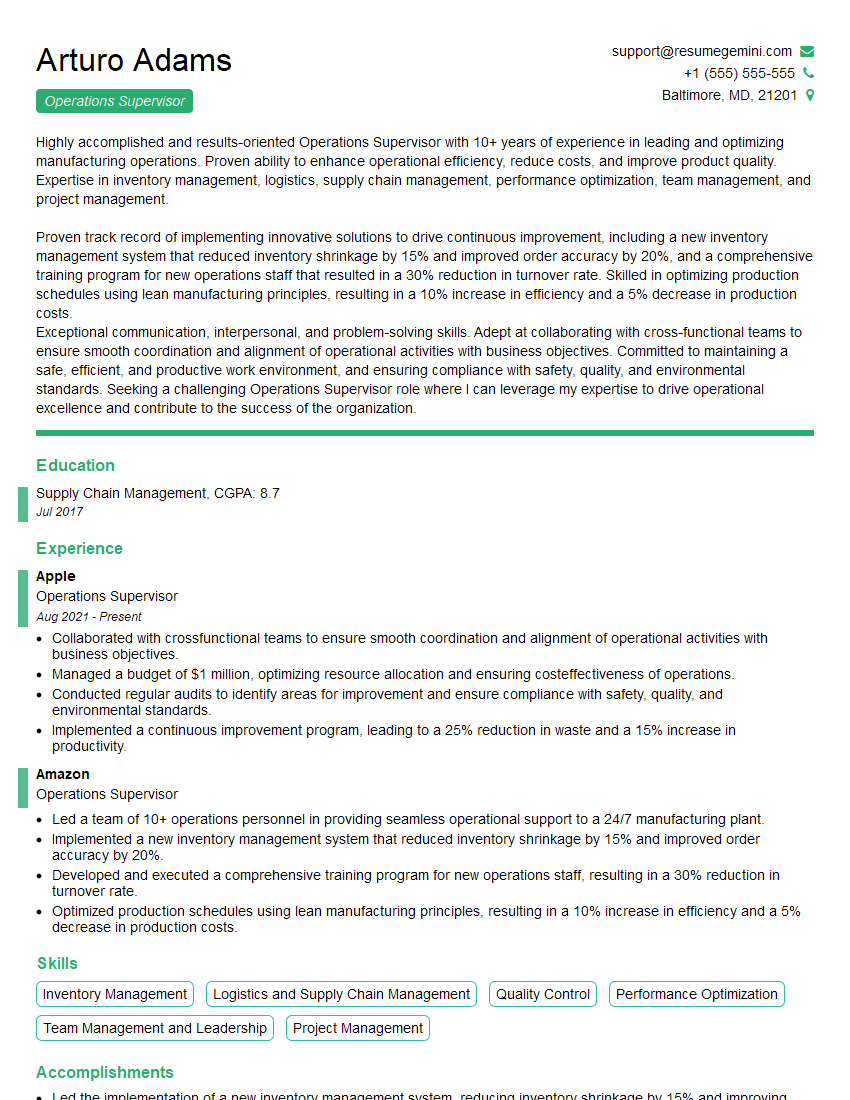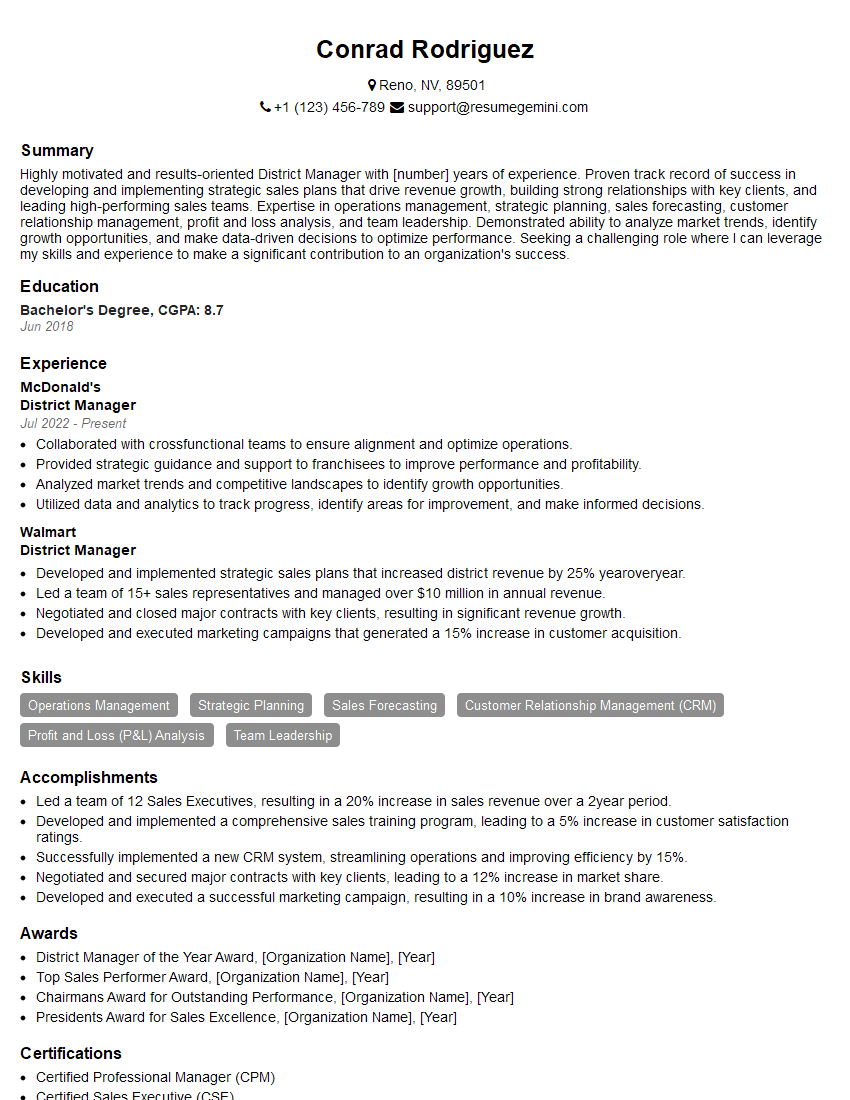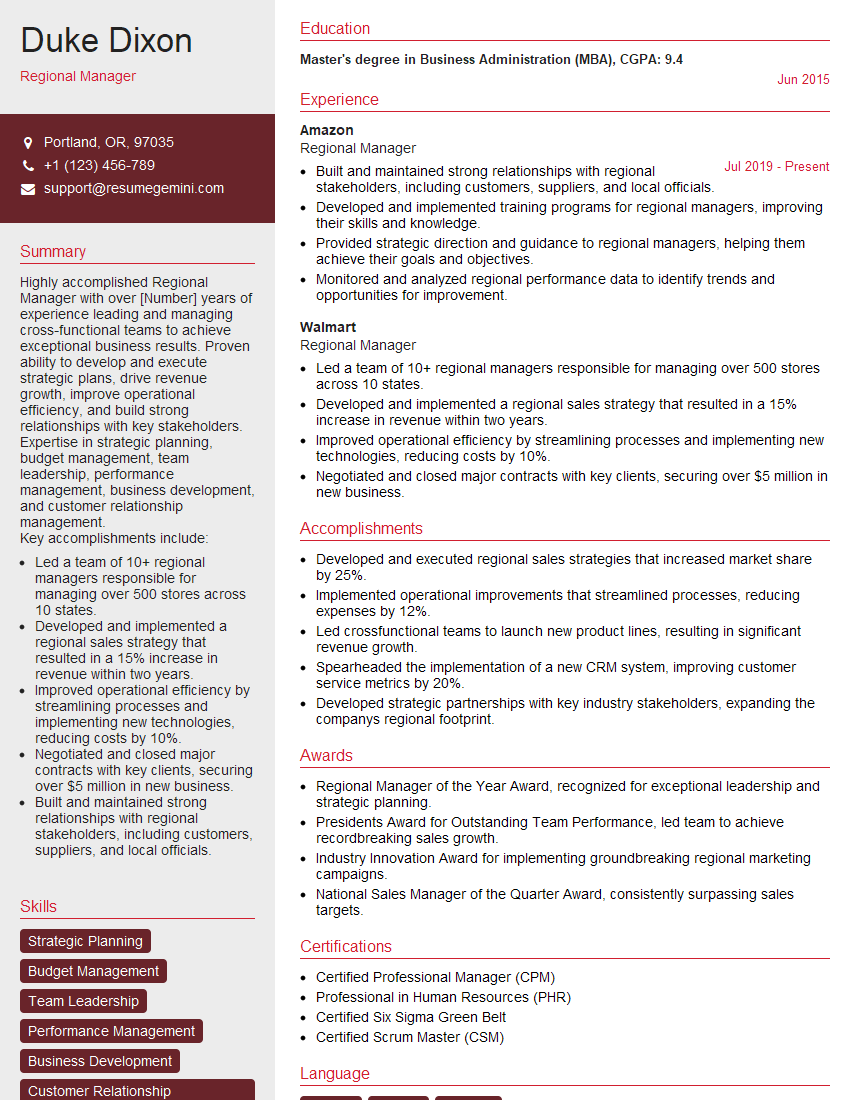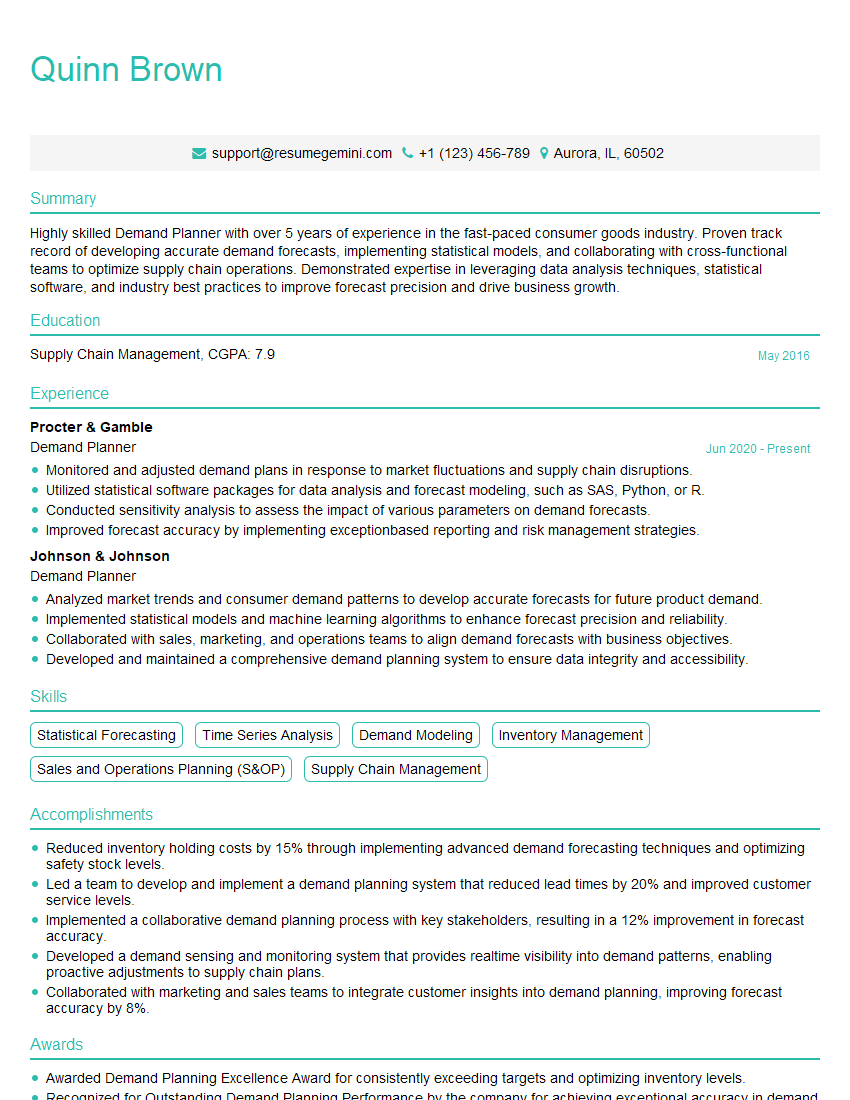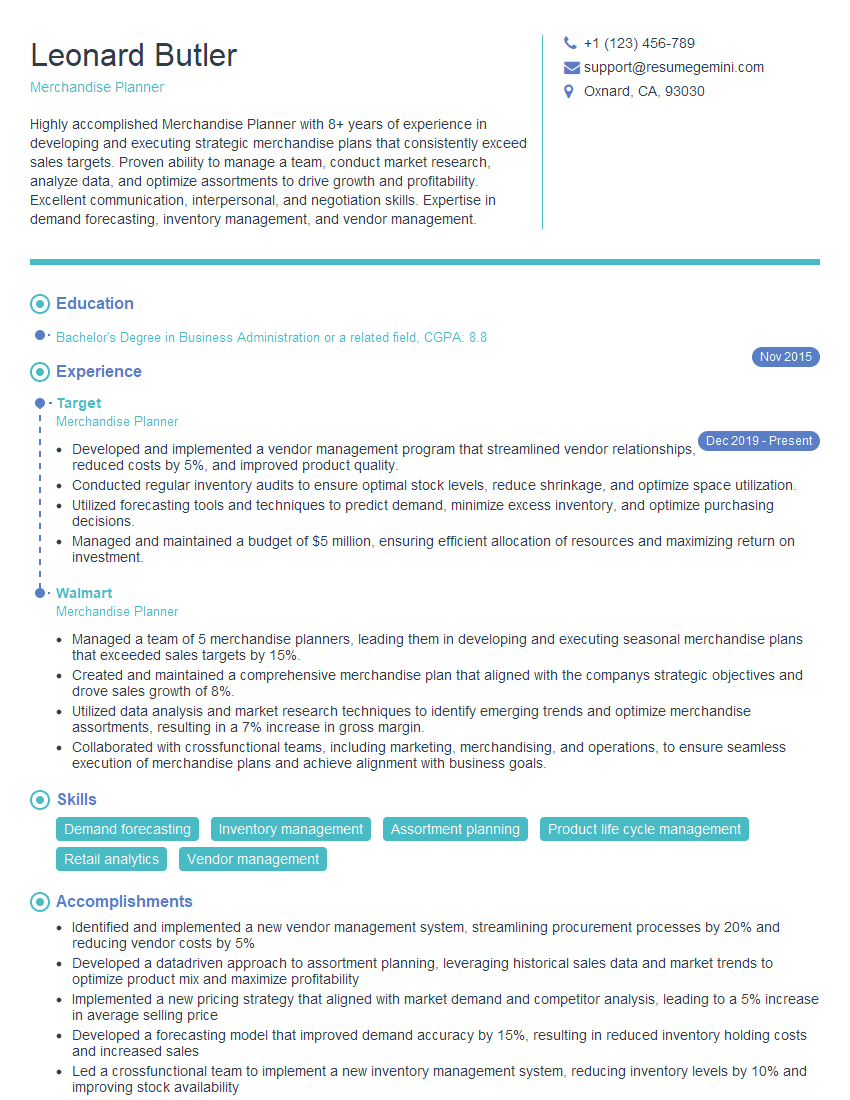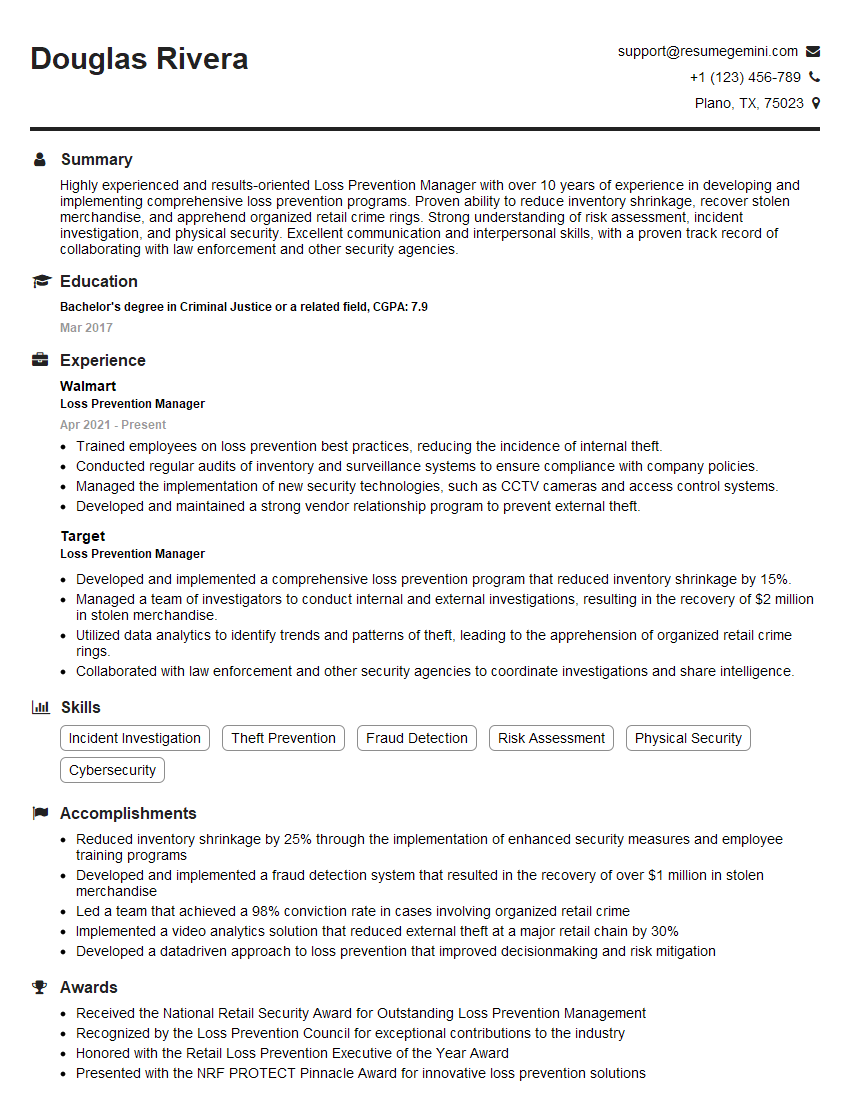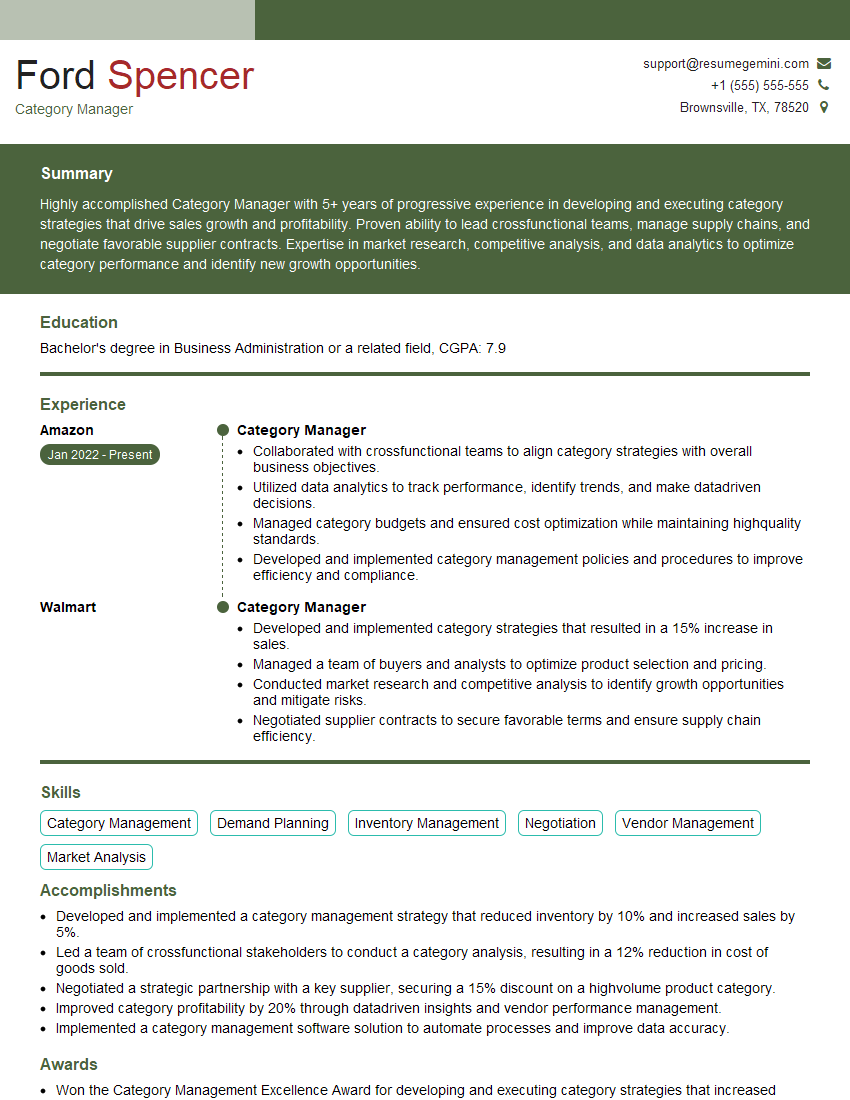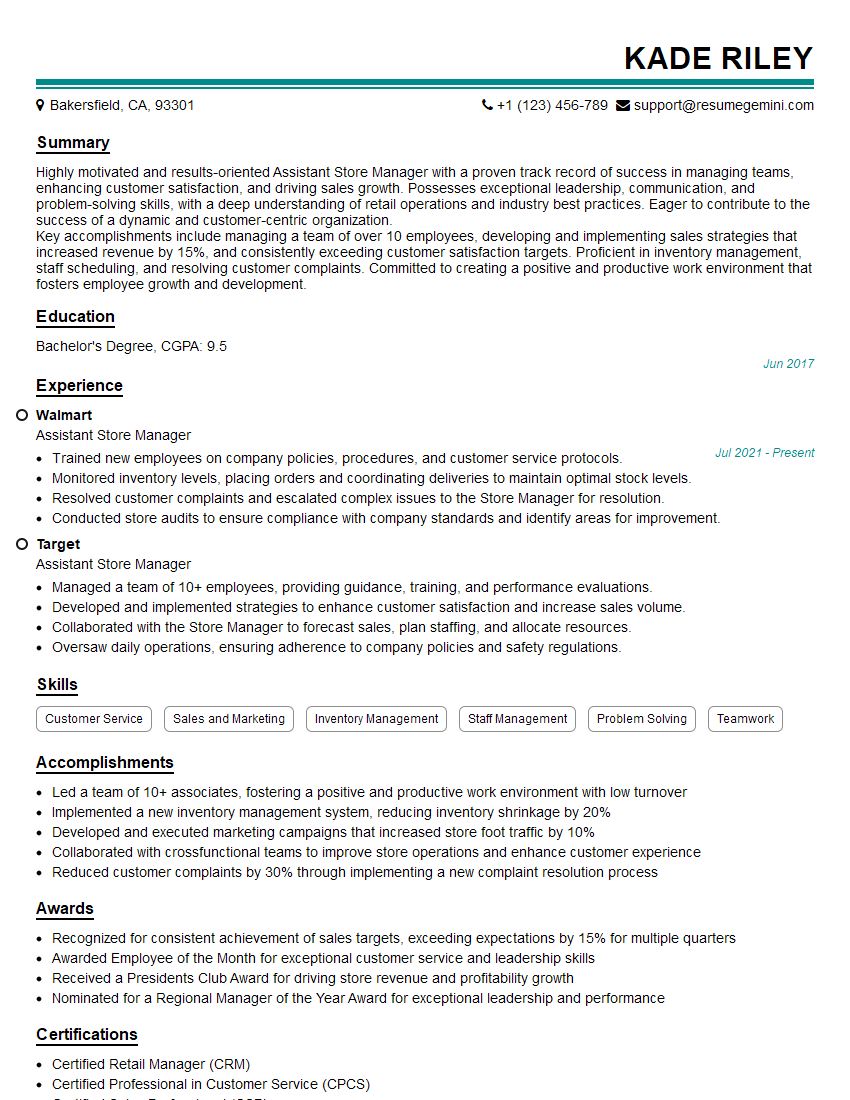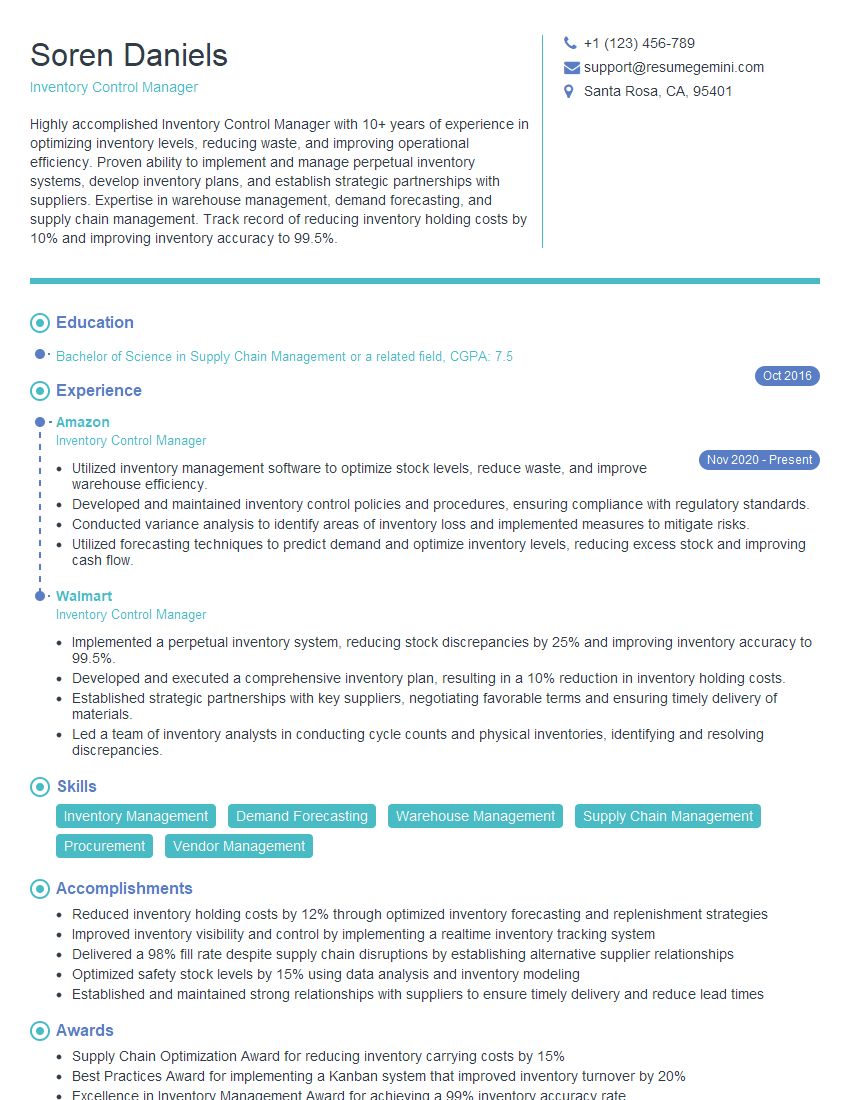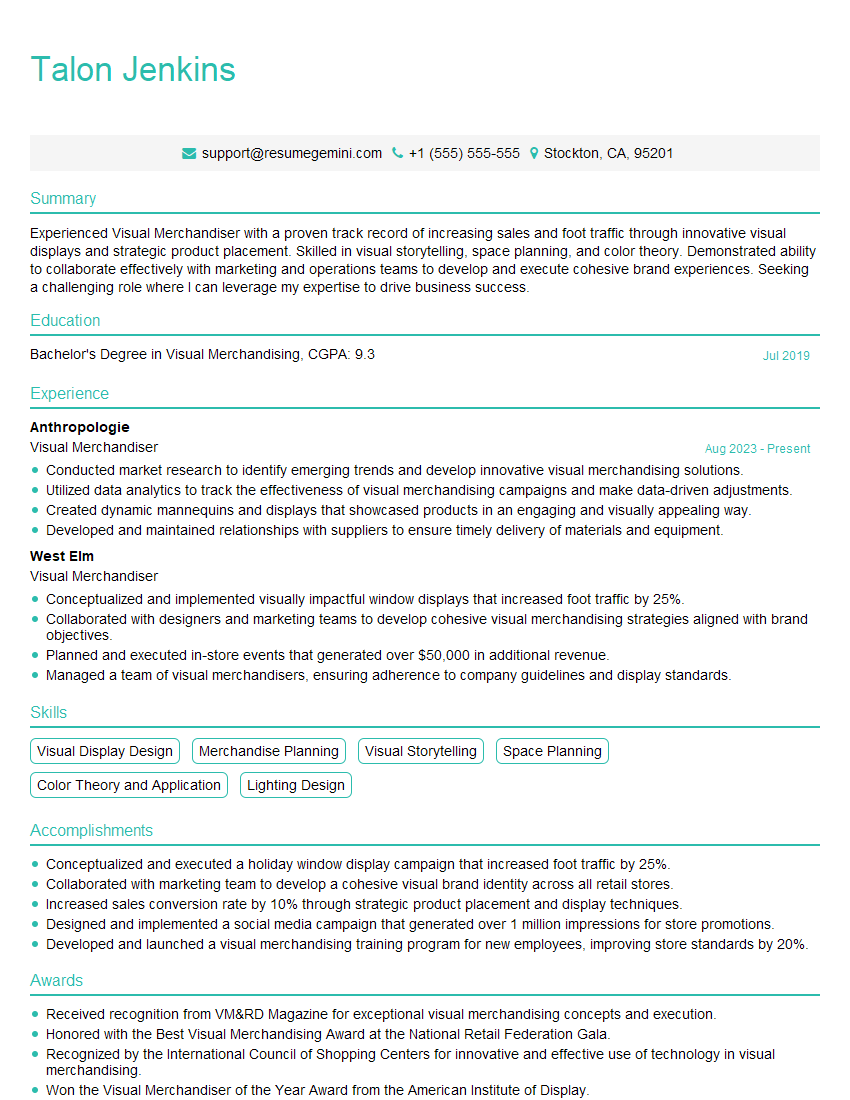Unlock your full potential by mastering the most common General Retail Operations interview questions. This blog offers a deep dive into the critical topics, ensuring you’re not only prepared to answer but to excel. With these insights, you’ll approach your interview with clarity and confidence.
Questions Asked in General Retail Operations Interview
Q 1. Describe your experience with inventory management systems.
Inventory management is the backbone of any successful retail operation. My experience encompasses utilizing various systems, from simple spreadsheet-based tracking to sophisticated enterprise resource planning (ERP) software. I’m proficient in using systems like SAP, Oracle Retail, and smaller, specialized inventory management solutions. My focus is always on accuracy, efficiency, and minimizing waste.
For example, in a previous role, we transitioned from a manual inventory system to a cloud-based solution. This improved accuracy by eliminating human error in data entry, allowed for real-time stock visibility across multiple locations, and ultimately reduced stockouts and overstocking. The new system also automated reordering, freeing up staff time for other critical tasks. We used ABC analysis (classifying inventory by value and consumption rate) to optimize our focus on high-value items, ensuring accurate tracking and minimizing losses.
Another example involves using cycle counting. Instead of a complete annual physical inventory, we implemented a system of regularly counting small sections of inventory, which provided a continuous and more accurate picture of our stock than a large, infrequent count. This methodology dramatically improved inventory accuracy and reduced the disruption to store operations.
Q 2. How do you handle peak seasons and increased customer traffic?
Handling peak seasons requires a multi-faceted approach, focusing on proactive planning and effective resource allocation. Increased customer traffic demands meticulous preparation to avoid bottlenecks and ensure a positive customer experience.
- Staffing: We project staffing needs based on historical sales data and anticipated demand. This often involves hiring temporary staff or adjusting employee schedules to accommodate the increased workload. Effective scheduling software and clear communication are vital.
- Inventory: Accurate forecasting is essential. We analyze sales trends from previous years, considering external factors like marketing campaigns and economic conditions, to predict demand and ensure sufficient stock levels to avoid stockouts. Strategic pre-stocking of high-demand items is key.
- Operations: We optimize store layouts to improve flow and minimize congestion during peak times. This might involve strategically placing high-demand items and ensuring ample checkout lanes are open. We also implement strategies to manage lines effectively, such as utilizing digital queuing systems or additional self-checkout options.
- Technology: Implementing POS (Point of Sale) systems that handle high transaction volumes smoothly is critical. We also explore using tools to facilitate online ordering and in-store pickup or delivery to manage increased demand more efficiently.
For instance, during the holiday season, we significantly increased staffing levels by 25% and pre-stocked popular gift items weeks in advance. We also used digital signage to direct customers to less crowded areas and offered expedited checkout options to reduce wait times.
Q 3. What strategies have you used to improve store efficiency?
Improving store efficiency involves identifying bottlenecks and streamlining processes across various areas of the store operations. It requires a data-driven approach, combined with continuous process improvement methodologies.
- Process Optimization: We analyze workflows, identifying redundant steps and areas for improvement. For instance, we may redesign stockroom organization to optimize picking and packing processes.
- Technology Integration: Implementing tools like automated inventory tracking, mobile POS systems, and customer relationship management (CRM) software can significantly enhance efficiency and reduce manual tasks.
- Employee Empowerment: Training employees on efficient work practices and providing them with the necessary tools and autonomy to solve problems improves overall productivity and reduces errors.
- Data Analysis: Tracking key performance indicators (KPIs) like sales per hour, transaction speed, and shrinkage helps identify areas for improvement. For example, regularly reviewing sales data can reveal slow-moving items which allows for optimized pricing and promotion strategies.
In one store, we implemented a new inventory management system that reduced the time spent on manual stock counts by 50%, freeing up employees to focus on customer service. We also reorganized the backroom, improving workflow and reducing the time it took to restock shelves.
Q 4. Explain your approach to loss prevention and shrinkage reduction.
Loss prevention and shrinkage reduction require a comprehensive strategy incorporating multiple layers of security and procedural safeguards. Shrinkage, the difference between inventory and sales, is a major concern for retailers, often caused by theft, damage, or errors.
- Security Measures: This includes implementing robust security systems such as CCTV cameras, electronic article surveillance (EAS) tags, and secure storage areas for high-value items.
- Employee Training: Thorough training on loss prevention procedures, including proper cash handling, inventory control, and recognizing suspicious behavior, is crucial. Employee accountability and integrity are key.
- Inventory Management: Accurate inventory control helps identify discrepancies and potential theft or damage. Regular cycle counting, as mentioned earlier, is vital.
- Data Analysis: Analyzing sales data and loss trends can reveal patterns and vulnerabilities. This data-driven approach allows for targeted interventions.
In a previous role, we implemented a new EAS system, resulting in a 20% reduction in shoplifting incidents. We also provided regular training to staff on recognizing and reporting suspicious activity, leading to increased vigilance and better loss prevention.
Q 5. How do you maintain accurate sales forecasting and reporting?
Accurate sales forecasting and reporting are vital for effective inventory management, planning, and resource allocation. My approach utilizes a combination of historical data, market trends, and predictive analytics.
- Historical Data Analysis: We analyze past sales data, considering seasonality, promotional periods, and economic factors to establish baseline trends. This data is used to create a foundation for future forecasts.
- Market Trend Analysis: We consider external factors such as competitor activity, consumer trends, and economic conditions to adjust our forecasts and anticipate changes in demand.
- Predictive Analytics: We leverage statistical models and forecasting software to refine our predictions, accounting for uncertainty and potential variations.
- Regular Reporting and Review: We generate regular sales reports, comparing actual sales to forecasts and identifying areas of variance. This allows us to adjust strategies and improve future forecasting accuracy.
For instance, we use a combination of time series analysis and regression modeling to predict sales for upcoming seasons. We also regularly review our forecasts and adjust them based on actual sales and market changes. This iterative process ensures that our forecasts remain relevant and accurate.
Q 6. Describe your experience with visual merchandising and its impact on sales.
Visual merchandising plays a crucial role in driving sales by creating an appealing and engaging shopping environment. It’s about strategically displaying products to attract customers and encourage purchases.
- Store Layout: Optimizing store layout, including product placement, signage, and lighting, to guide customer flow and highlight key items is critical.
- Product Presentation: Attractive and organized displays, including proper use of props, fixtures, and signage, enhance product visibility and appeal.
- Theme and Storytelling: Creating visually cohesive displays that tell a story or reflect current trends can significantly enhance customer engagement and purchase intent.
- Seasonal Changes: Adapting displays to reflect seasonal trends and promotional events keeps the store fresh and appealing to customers.
In one instance, we redesigned a store’s layout, focusing on creating more engaging displays and highlighting key product categories. This resulted in a 15% increase in sales within three months. The strategic placement of high-margin items near checkout lanes also boosted impulse purchases.
Q 7. How do you manage and motivate a retail team?
Managing and motivating a retail team requires a combination of strong leadership, effective communication, and a supportive work environment. It’s about fostering a culture of teamwork and shared goals.
- Clear Communication: Maintaining open and consistent communication with the team is paramount. This includes providing clear expectations, regular feedback, and opportunities for input.
- Team Building: Creating a positive and supportive team environment, fostering collaboration and teamwork, improves morale and productivity. Regular team meetings and social events can build camaraderie.
- Training and Development: Providing regular training and development opportunities helps employees develop their skills and advance their careers. This demonstrates a commitment to their growth and increases job satisfaction.
- Recognition and Rewards: Recognizing and rewarding employees for their contributions, both big and small, reinforces positive behaviors and motivates the team.
- Empowerment and Autonomy: Empowering employees to take ownership of their work and make decisions increases their engagement and job satisfaction.
I believe in leading by example and creating a supportive environment where employees feel valued and respected. By fostering a culture of teamwork and open communication, I’ve been successful in building high-performing retail teams that consistently exceed expectations.
Q 8. What metrics do you use to measure store performance?
Measuring store performance requires a holistic approach, looking beyond just sales figures. I utilize a range of key performance indicators (KPIs) categorized for better understanding and actionability.
- Financial Metrics: These directly impact profitability. Examples include sales revenue, gross profit margin (revenue minus cost of goods sold), operating profit, and return on investment (ROI) for specific promotions or initiatives. For instance, a high sales revenue might be misleading if the gross profit margin is low, indicating an issue with pricing or cost control.
- Operational Metrics: These assess efficiency and effectiveness of store operations. Key metrics include inventory turnover rate (how quickly inventory is sold), shrink rate (loss due to theft or damage), customer traffic, average transaction value (ATV), and conversion rate (percentage of shoppers who make a purchase). A low inventory turnover could signal overstocking or slow-moving products, while a high shrink rate needs immediate attention to improve security and stock management.
- Customer Metrics: These focus on customer satisfaction and loyalty. Metrics include customer satisfaction scores (CSAT) from surveys or feedback forms, customer retention rate, net promoter score (NPS), and average order value (AOV). A declining NPS signifies a need to address customer concerns and improve the overall shopping experience.
- Employee Metrics: Measuring employee performance contributes to overall store success. Metrics include employee turnover rate, employee satisfaction, and sales per employee. High employee turnover can indicate issues with management, compensation, or working conditions.
By regularly tracking and analyzing these metrics, I can identify areas for improvement, celebrate successes, and make data-driven decisions to optimize store performance. I often use dashboards and reporting tools to visualize these KPIs and make them easily accessible to the store team.
Q 9. How do you handle customer complaints and difficult situations?
Handling customer complaints and difficult situations requires empathy, active listening, and a problem-solving approach. My strategy involves a structured process:
- Active Listening and Empathy: I begin by letting the customer fully express their concerns without interruption, showing genuine empathy and understanding. This often de-escalates the situation.
- Acknowledge and Validate: I acknowledge the customer’s feelings and validate their concerns, even if I don’t necessarily agree with their perspective. A simple phrase like, “I understand your frustration,” can go a long way.
- Gather Information: I ask clarifying questions to understand the root cause of the complaint. This ensures I address the specific issue and not just the symptoms.
- Find a Solution: Based on the gathered information, I propose a solution that satisfies the customer, whether it’s a refund, exchange, discount, or a promise to investigate the problem further. I aim for a win-win outcome.
- Follow Up: I follow up with the customer to ensure they are satisfied with the resolution. This demonstrates a commitment to customer service and builds loyalty.
For particularly difficult situations, I involve a manager or supervisor to ensure appropriate escalation and support. Documentation of the complaint and resolution is crucial for future reference and improvement of processes.
For example, I once handled a situation where a customer was upset about a damaged product. By carefully listening to their concerns, offering a sincere apology, and promptly offering a replacement, I was able to turn a negative experience into a positive one, retaining the customer’s trust and loyalty.
Q 10. Explain your experience with scheduling and staff allocation.
Effective scheduling and staff allocation are critical for maximizing store efficiency and providing optimal customer service. My experience includes:
- Forecasting Demand: I analyze historical sales data, predicted promotions, and anticipated customer traffic to accurately forecast staffing needs for each shift. This helps avoid overstaffing or understaffing, both of which impact profitability and customer service.
- Skill-Based Scheduling: I consider the skills and expertise of each employee when creating schedules. This ensures the right people are assigned to tasks that best utilize their abilities, such as cashiers, stock personnel, or customer service representatives. For example, scheduling experienced employees during peak hours improves checkout speed and customer satisfaction.
- Employee Preferences: When possible, I consider employee availability and preferences to ensure fair scheduling practices and maintain high morale. This balances business needs with employee well-being.
- Technology Integration: I utilize scheduling software to streamline the process, optimize staff allocation, and automate tasks like shift swapping or time-off requests. This enhances efficiency and reduces administrative burden.
- Monitoring and Adjustment: I regularly monitor the schedule’s effectiveness and make adjustments as needed based on real-time data on customer traffic and sales. Flexibility is key to respond to unexpected events or changes in demand.
By effectively managing scheduling and staff allocation, I have consistently ensured optimal coverage during peak times, improved employee satisfaction, and reduced labor costs, leading to improved operational efficiency and profitability.
Q 11. How familiar are you with different POS systems?
I am proficient in several POS (Point of Sale) systems, including Square, Shopify POS, Lightspeed, and Clover. My experience encompasses not only operating these systems but also troubleshooting issues, processing various payment types, managing inventory through the POS, and generating reports.
My familiarity extends to both cloud-based and on-premise systems, and I understand the advantages and disadvantages of each. For instance, cloud-based systems offer flexibility and accessibility but might depend on a reliable internet connection, while on-premise systems require more IT infrastructure management but offer greater control over data. I am comfortable training staff on new POS systems and assisting with the transition to a new platform. I am also adept at adapting to new POS systems quickly, as the retail landscape constantly evolves.
Q 12. Describe your experience with implementing new retail technologies.
I have extensive experience implementing new retail technologies, including mobile POS systems, customer relationship management (CRM) software, and inventory management systems. My approach involves:
- Needs Assessment: I start by clearly defining the business needs and goals the new technology aims to achieve. This ensures the chosen technology aligns with the store’s objectives.
- Technology Selection: I research and evaluate different technology options based on cost, functionality, integration with existing systems, and vendor support. This includes careful consideration of vendor reputation and long-term support.
- Implementation Planning: I develop a detailed implementation plan outlining timelines, resources, training requirements, and potential challenges. This includes thorough testing of the system before full rollout.
- Training and Support: I provide comprehensive training to staff on the new technology, ensuring they are comfortable using the system and can troubleshoot basic issues. Ongoing support and mentorship are also crucial for successful adoption.
- Data Migration: If necessary, I manage the migration of data from existing systems to the new technology. This requires careful planning to avoid data loss or inconsistencies.
- Post-Implementation Review: After implementation, I conduct a post-implementation review to evaluate the success of the project and identify areas for improvement. This includes monitoring key metrics to track the impact of the new technology on store performance.
For example, I successfully implemented a mobile POS system in a previous role, which streamlined checkout processes, increased sales, and enhanced customer satisfaction through more efficient order fulfillment. This resulted in a measurable increase in sales and improved customer feedback scores.
Q 13. How do you ensure compliance with company policies and regulations?
Ensuring compliance with company policies and regulations is a crucial aspect of retail operations. My approach is multifaceted:
- Thorough Understanding: I ensure a complete understanding of all applicable company policies, local, state, and federal regulations, including those related to health and safety, data privacy (like GDPR or CCPA), age restrictions on alcohol or tobacco sales, and labor laws.
- Regular Training: I conduct or participate in regular training sessions for staff on compliance procedures. This includes updates on any changes to regulations or company policies.
- Documentation and Record-Keeping: I maintain meticulous records of all compliance-related activities, including training records, incident reports, and audits. This provides a clear audit trail and facilitates easy access to information.
- Internal Audits: I participate in or conduct regular internal audits to assess compliance with policies and regulations. This helps identify any gaps in compliance and allows for corrective actions to be taken.
- Proactive Approach: I adopt a proactive approach to compliance, anticipating potential issues and taking steps to prevent non-compliance. For example, regularly reviewing and updating safety procedures or ensuring proper age verification processes are in place.
- Reporting and Escalation: I promptly report any identified compliance issues to the appropriate management personnel. This ensures timely resolution and prevents escalation of problems.
By following these measures, I have consistently maintained a high level of compliance in previous roles, preventing potential legal issues and protecting the reputation of the company.
Q 14. How do you analyze sales data to identify trends and opportunities?
Analyzing sales data to identify trends and opportunities is crucial for informed decision-making in retail. My approach combines quantitative analysis with qualitative insights:
- Data Collection and Cleaning: I begin by collecting sales data from various sources, including the POS system, inventory management systems, and customer relationship management (CRM) software. This data needs to be cleaned to ensure accuracy and reliability before analysis.
- Trend Identification: Using data visualization tools and statistical analysis techniques, I identify trends in sales patterns, such as seasonal fluctuations, best-selling products, and emerging product categories. For example, I might identify a consistent increase in sales of a particular product during the holiday season.
- Identifying Opportunities: Based on the identified trends, I explore potential opportunities for growth, such as targeted promotions, new product introductions, inventory optimization, or adjustments to pricing strategies. For instance, analyzing sales data might reveal an opportunity to introduce a complementary product to an existing best-seller.
- Comparative Analysis: I compare sales data across different time periods, store locations, or product categories to identify areas of strength and weakness. This comparative analysis helps to identify high-performing and low-performing areas.
- Qualitative Insights: I combine quantitative analysis with qualitative insights from customer feedback, employee observations, and market research to gain a holistic understanding of sales trends and opportunities. This adds context to the numbers and provides a more complete picture.
- Actionable Recommendations: Finally, I translate my analysis into actionable recommendations for the store team, including specific strategies for improving sales, managing inventory, or enhancing the customer experience. This ensures that insights are translated into concrete actions.
For example, in a past role, my analysis of sales data revealed a consistent underperformance of a particular product category. By combining quantitative analysis with customer feedback, I identified the reason for the underperformance and recommended changes to product displays, pricing, and promotional activities. This resulted in a significant improvement in sales of the underperforming product category.
Q 15. What experience do you have with supply chain management in retail?
My experience in retail supply chain management spans over ten years, encompassing all aspects from procurement and inventory management to logistics and distribution. In my previous role at ‘Retail Giant Inc.’, I was instrumental in implementing a new warehouse management system (WMS) that reduced order fulfillment time by 15% and improved inventory accuracy by 10%. This involved not only the technical implementation but also extensive staff training and process optimization. I’ve also worked extensively with forecasting models to predict demand and optimize stock levels, minimizing waste and maximizing profitability. I’m proficient in utilizing various software platforms for tracking and managing the entire supply chain process, from point of origin to the end consumer.
For example, we used predictive analytics to identify seasonal peaks in demand for specific product lines, allowing us to proactively adjust our purchasing orders and warehouse capacity. This prevented stockouts during critical sales periods and avoided unnecessary storage costs during slower times.
Career Expert Tips:
- Ace those interviews! Prepare effectively by reviewing the Top 50 Most Common Interview Questions on ResumeGemini.
- Navigate your job search with confidence! Explore a wide range of Career Tips on ResumeGemini. Learn about common challenges and recommendations to overcome them.
- Craft the perfect resume! Master the Art of Resume Writing with ResumeGemini’s guide. Showcase your unique qualifications and achievements effectively.
- Don’t miss out on holiday savings! Build your dream resume with ResumeGemini’s ATS optimized templates.
Q 16. How do you manage stock levels to avoid overstocking or stockouts?
Managing stock levels effectively requires a multi-faceted approach combining forecasting, data analysis, and real-time monitoring. The goal is to find the sweet spot between avoiding overstocking (leading to storage costs, obsolescence, and potential markdowns) and stockouts (resulting in lost sales and customer dissatisfaction). I use a combination of techniques to achieve this:
- Demand Forecasting: I leverage historical sales data, seasonal trends, and market analysis to predict future demand. This involves using statistical models and collaborating with marketing and sales teams to factor in promotional activities and external market influences.
- Inventory Management Systems (IMS): Utilizing sophisticated IMS software provides real-time visibility into inventory levels across all locations. This allows for prompt identification of slow-moving or obsolete items and enables timely replenishment of high-demand products.
- ABC Analysis: This inventory classification method categorizes products into A (high-value, high-demand), B (medium-value, medium-demand), and C (low-value, low-demand) items. This allows for focused attention on managing A-items more closely, minimizing the risk of stockouts for crucial products.
- Safety Stock Levels: I determine appropriate safety stock levels to account for unforeseen fluctuations in demand or supply chain disruptions. This involves considering factors such as lead times, demand variability, and service level targets.
For instance, during a recent promotional campaign, by closely monitoring sales data and adjusting safety stock levels dynamically, we avoided stockouts for our flagship product despite a much higher than expected demand.
Q 17. Describe your experience with budgeting and financial planning in a retail environment.
My experience in retail budgeting and financial planning involves developing and managing annual budgets, monitoring performance against targets, and identifying opportunities for cost optimization. At ‘Retail Giant Inc.’, I was responsible for preparing the departmental budget, forecasting sales, and controlling expenses. This included analyzing historical data, predicting future trends, and aligning budget allocations with strategic business objectives. I have a strong understanding of key financial metrics such as gross margin, operating profit, and return on investment (ROI). I also utilize various financial planning and analysis (FP&A) tools to track performance and identify potential issues.
One successful example was identifying an opportunity to reduce energy consumption in our stores by implementing energy-efficient lighting and refrigeration systems. This initiative not only reduced our operating expenses but also aligned with our company’s sustainability goals.
Q 18. How do you ensure a positive and productive work environment?
Creating a positive and productive work environment is paramount to achieving business success. My approach focuses on fostering open communication, teamwork, and mutual respect. I believe in empowering employees by providing them with clear expectations, the necessary resources, and opportunities for growth. I also encourage regular feedback, both from myself to my team and vice-versa. This creates a transparent environment where concerns can be addressed proactively and collaboratively. I regularly organize team-building activities to strengthen relationships and improve morale.
For example, I implemented a system of regular one-on-one meetings with each team member to discuss their progress, address any challenges, and provide mentorship. This resulted in improved employee engagement and retention.
Q 19. How have you improved customer satisfaction in a previous role?
Improving customer satisfaction is a continuous process requiring a focus on both proactive measures and reactive problem-solving. In my previous role, we implemented a customer feedback system that collected data through surveys, online reviews, and direct customer interactions. This data allowed us to identify areas for improvement in areas such as product quality, customer service, and store environment. We then used this feedback to develop targeted initiatives to address these issues.
For instance, customer feedback highlighted slow checkout times. By analyzing the data, we discovered bottlenecks and implemented changes such as additional self-checkout kiosks and staff training, which resulted in a significant reduction in wait times and an increase in positive customer reviews.
Q 20. What is your experience with analyzing customer data?
Analyzing customer data is crucial for making informed business decisions. I’m proficient in using various analytical tools and techniques to extract meaningful insights from customer data, including demographics, purchase history, website browsing behavior, and social media interactions. This involves using statistical analysis, data visualization, and data mining techniques. I then translate these insights into actionable strategies to improve customer engagement and drive sales.
For example, by analyzing customer purchase patterns, we were able to identify a previously untapped market segment and tailor our marketing campaigns to reach them. This resulted in a significant increase in sales within that specific segment.
Q 21. How do you handle employee training and development?
Employee training and development is crucial for maintaining a skilled and motivated workforce. My approach is multi-faceted, incorporating both on-the-job training and formal development programs. On-the-job training involves mentoring and shadowing experienced colleagues, while formal programs can include workshops, online courses, and external certifications. I focus on providing relevant training that aligns with individual career goals and business needs. I also encourage employees to participate in industry events and conferences to broaden their knowledge and stay updated on industry trends.
For instance, I developed a comprehensive training program for our new POS system which involved both classroom training and hands-on practice. This ensured a smooth transition to the new system and minimized disruptions to daily operations.
Q 22. Explain your problem-solving approach in a high-pressure retail setting.
In high-pressure retail situations, my problem-solving approach is systematic and prioritizes quick, effective action while maintaining customer satisfaction. I follow a four-step process: Identify, Analyze, Act, Evaluate.
- Identify: Quickly pinpoint the core problem. Is it a customer complaint? A staffing shortage? A supply chain issue? Clearly defining the problem is the first crucial step. For example, if a customer is upset about a faulty product, I immediately acknowledge their frustration and listen to their concerns without interrupting.
- Analyze: Gather relevant information to understand the situation’s context. If it’s a faulty product, I’d check the product’s condition, warranty information, and relevant store policies. If it’s a staffing shortage, I’d assess the current workload and employee availability.
- Act: Based on my analysis, I take immediate action to resolve the problem. This could involve offering a replacement product, issuing a refund, reassigning tasks, or calling for additional support. Speed and efficiency are key here; a quick resolution minimizes customer frustration.
- Evaluate: After resolving the problem, I take time to reflect on the process. Was my solution effective? Could I have done something differently to improve the outcome or prevent similar issues in the future? This iterative approach ensures continuous improvement.
For instance, during a Black Friday rush, we experienced a point-of-sale system failure. I immediately identified the issue, analyzed the problem by checking network connectivity and informing my manager, acted by directing customers to alternative payment methods and manually processing transactions, and evaluated the situation post-event to ensure such failures were prevented through system backups and staff training.
Q 23. How do you prioritize tasks and manage your time effectively?
Prioritizing tasks and managing time effectively in retail requires a blend of planning, organization, and adaptability. I use a combination of techniques:
- Prioritization Matrix: I use the Eisenhower Matrix (Urgent/Important) to categorize tasks. Urgent and important tasks are tackled immediately, important but not urgent tasks are scheduled, urgent but not important tasks are delegated if possible, and unimportant tasks are eliminated.
- Time Blocking: I allocate specific time slots for different tasks, ensuring sufficient time for high-priority activities. This helps prevent multitasking and improves focus.
- To-Do Lists: I maintain detailed to-do lists, regularly updating them and prioritizing items based on deadlines and importance. This provides a clear overview of my workload.
- Delegation: I effectively delegate tasks to team members whenever possible, empowering them and freeing up my time for more strategic initiatives. This requires clear communication and trust in the team’s abilities.
- Flexibility: In a retail environment, unexpected events are common. I remain flexible and adaptable, adjusting my schedule to accommodate unforeseen circumstances such as customer issues or stock discrepancies.
For example, I might block out time in the morning to address administrative tasks, mid-day for customer interactions, and the late afternoon for inventory management. However, if a large customer order comes in unexpectedly, I’ll adjust my schedule to prioritize fulfilling that order.
Q 24. What is your understanding of retail KPIs (Key Performance Indicators)?
Retail KPIs are quantifiable metrics used to track and assess the performance of a retail business. They provide insights into various aspects of the business, allowing for informed decision-making. Key examples include:
- Sales Revenue: Total revenue generated over a specific period. This is a fundamental KPI indicating overall business performance.
- Conversion Rate: Percentage of customers who make a purchase after visiting the store or website. A higher conversion rate indicates effective marketing and sales strategies.
- Average Transaction Value (ATV): Average amount spent per transaction. Increasing ATV indicates successful upselling and cross-selling efforts.
- Customer Acquisition Cost (CAC): Cost of acquiring a new customer. This helps evaluate the efficiency of marketing campaigns.
- Inventory Turnover: How quickly inventory is sold and replenished. A high turnover rate indicates efficient inventory management.
- Gross Margin: Difference between revenue and cost of goods sold. A higher gross margin shows profitability.
- Customer Satisfaction (CSAT): Measured through surveys or feedback, reflecting customer happiness with products and services.
- Employee Turnover: Rate at which employees leave the company. High turnover can be costly and disruptive.
Analyzing these KPIs together provides a holistic view of retail performance, highlighting areas for improvement and guiding strategic planning. For example, if sales revenue is low despite a high number of website visits, the conversion rate needs to be investigated and addressed.
Q 25. How do you use technology to improve retail operations?
Technology plays a vital role in enhancing retail operations, offering efficiency and improved customer experience. My experience encompasses several areas:
- Point-of-Sale (POS) Systems: Modern POS systems streamline transactions, manage inventory, and track sales data in real-time, reducing errors and improving accuracy. I’m proficient in using various POS systems, from traditional cash registers to cloud-based solutions.
- Inventory Management Software: Software solutions optimize stock levels, predict demand, and automate ordering processes, minimizing stockouts and reducing waste. This includes experience with both manual and automated inventory tracking systems.
- Customer Relationship Management (CRM) Systems: CRM systems help track customer interactions, preferences, and purchase history, enabling personalized marketing and improved customer service. I have experience utilizing CRM data for targeted promotions and loyalty programs.
- E-commerce Platforms: Managing online stores involves utilizing e-commerce platforms to process orders, manage inventory, and provide seamless online shopping experiences. This includes optimizing website design, payment gateways, and shipping methods.
- Data Analytics: Analyzing sales data, customer demographics, and other KPIs provides valuable insights for improving business decisions. I have experience using data analytics tools to identify trends, optimize pricing, and improve marketing strategies.
For example, using data analytics, I identified a correlation between customer purchases and specific promotional offers, leading to more targeted advertising campaigns that increased sales.
Q 26. Describe your experience with omnichannel retail strategies.
Omnichannel retail strategies focus on providing a seamless and integrated shopping experience across all channels – online, mobile, and physical stores. My experience includes:
- Unified Customer View: Ensuring consistent customer data across all channels, enabling personalized service regardless of the interaction point (website, app, store).
- Integrated Inventory Management: Managing inventory across all channels to prevent stockouts and optimize fulfillment, whether online or in-store pickup.
- Consistent Branding and Messaging: Maintaining a consistent brand identity and messaging across all platforms to create a cohesive customer experience.
- Seamless Order Fulfillment: Offering multiple fulfillment options, such as buy online, pick up in-store (BOPIS), or ship-from-store, to cater to diverse customer preferences.
- Personalized Customer Service: Using customer data to offer tailored recommendations, promotions, and customer service across channels.
For example, I’ve been involved in implementing a BOPIS system, which significantly improved customer satisfaction and reduced delivery costs by allowing customers to collect their online orders conveniently from our physical store.
Q 27. How do you ensure the safety and security of your store and employees?
Ensuring the safety and security of the store and employees is paramount. My approach is multifaceted:
- Employee Training: Regular training on safety procedures, security protocols (e.g., handling cash, dealing with shoplifters), and emergency response plans is crucial. This includes training on recognizing and responding to suspicious behavior.
- Security Systems: Utilizing security systems, such as CCTV cameras, alarm systems, and security tags on merchandise, to deter theft and monitor store activity. Regular maintenance and updates of these systems are vital.
- Safe Work Environment: Maintaining a clean, well-lit, and organized store environment minimizes accidents and enhances employee safety. This includes regular checks of equipment and walkways to identify and address potential hazards.
- Emergency Preparedness: Developing and regularly practicing emergency procedures (e.g., fire drills, evacuation plans) ensures efficient responses to unforeseen events. Employees need to be fully briefed and regularly trained in these protocols.
- Loss Prevention Strategies: Implementing loss prevention strategies such as visual merchandising, employee monitoring, and security audits helps minimize shrinkage (loss of inventory due to theft or damage).
For instance, I implemented a buddy system for employees closing the store late at night, improving their safety and security significantly. We also conduct regular security audits to identify vulnerabilities and improve our overall security measures.
Q 28. What is your experience with managing returns and exchanges?
Efficiently managing returns and exchanges is vital for customer satisfaction and minimizing losses. My approach involves:
- Clear Return Policy: Communicating a clear and concise return policy to customers, highlighting eligibility criteria, time limits, and refund procedures.
- Streamlined Process: Establishing a simple and efficient return and exchange process, minimizing paperwork and wait times for customers. This could involve using mobile POS devices for processing returns at the point of interaction.
- Inventory Management: Tracking returned items and ensuring they are properly inspected, restocked, or disposed of appropriately. Proper inventory management is key to understanding return rates and informing future purchasing decisions.
- Customer Service: Providing courteous and professional customer service during returns and exchanges. Addressing customer concerns promptly and efficiently helps resolve issues and build customer loyalty.
- Data Analysis: Analyzing return data to identify potential issues with products or processes. This information can inform improvements in product quality, marketing, or customer service.
For example, we implemented a system where customers can initiate returns online, generating a pre-printed return label, streamlining the entire process and improving customer convenience. Analyzing return data, we identified a specific product with unusually high returns and proactively addressed the quality issue with the supplier.
Key Topics to Learn for General Retail Operations Interview
- Customer Service Excellence: Understanding different customer interaction styles, conflict resolution techniques, and building rapport to enhance the shopping experience. Practical application includes role-playing scenarios and analyzing customer feedback.
- Inventory Management: Mastering stock control, cycle counting, minimizing shrinkage, and understanding the impact of efficient inventory management on profitability. Practical application includes discussing strategies for optimizing stock levels and addressing discrepancies.
- Visual Merchandising & Store Presentation: Learning how to create an attractive and engaging store layout, maximizing product visibility, and understanding the psychology of retail display. Practical application includes analyzing successful store layouts and proposing improvements.
- Sales Techniques & Processes: Understanding different sales strategies, suggestive selling, upselling, and cross-selling techniques to increase sales revenue. Practical application involves developing strategies for achieving individual and team sales targets.
- Teamwork & Collaboration: Demonstrating skills in effective communication, delegation, conflict resolution, and supporting colleagues to achieve shared goals. Practical application involves discussing experiences working in a team environment and contributing to team success.
- Loss Prevention & Security: Understanding procedures for preventing shoplifting, handling cash, and adhering to security protocols. Practical application involves outlining strategies for minimizing losses and ensuring a safe environment for staff and customers.
- Store Operations & Procedures: Understanding daily operational tasks, opening/closing procedures, cash handling, and adhering to company policies and procedures. Practical application includes outlining your approach to ensuring efficient store operations.
Next Steps
Mastering General Retail Operations is crucial for career advancement, opening doors to supervisory roles, district management, and even corporate positions. A strong understanding of these areas demonstrates your commitment to operational excellence and customer satisfaction. To maximize your job prospects, create an ATS-friendly resume that highlights your skills and experience effectively. ResumeGemini is a trusted resource to help you build a professional and impactful resume that catches the eye of recruiters. We provide examples of resumes tailored to General Retail Operations to guide you in crafting yours.
Explore more articles
Users Rating of Our Blogs
Share Your Experience
We value your feedback! Please rate our content and share your thoughts (optional).
What Readers Say About Our Blog
Hi, I have something for you and recorded a quick Loom video to show the kind of value I can bring to you.
Even if we don’t work together, I’m confident you’ll take away something valuable and learn a few new ideas.
Here’s the link: https://bit.ly/loom-video-daniel
Would love your thoughts after watching!
– Daniel
This was kind of a unique content I found around the specialized skills. Very helpful questions and good detailed answers.
Very Helpful blog, thank you Interviewgemini team.
